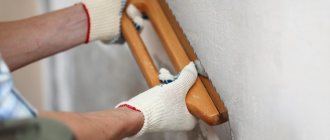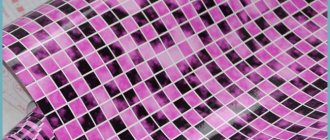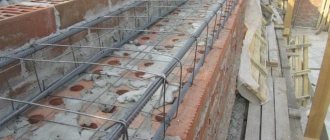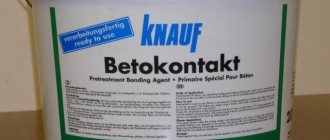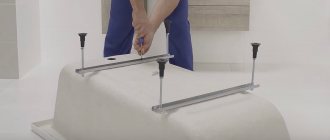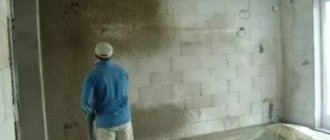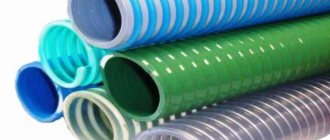Preparing a brick wall for plastering internal surfaces and plastering the facade
Even when planning the work, you will need to decide how to properly plaster a brick wall. The durability of the finish depends on the preparation of the surface for applying the mixture.
The reasons for plaster lag are:
- layer of old coating;
- oil stains from paint;
- surface poorly cleaned of wallpaper residues.
Before applying the composition, the wall will need to be repaired. Assessing the evenness and inspecting the object allows you to determine how to properly plaster, outline the treatment area and calculate the need for materials.
Preparatory stages include:
- Completion of construction and installation of the wall.
- Cleaning of old coating, wallpaper and paint.
- Sealing cracks that serve as a source of condensation reduces sound insulation and increases heat loss.
- Expansion of masonry joints for strong adhesion of the plaster to the surface.
- Applying notches to create adhesion.
- Penetrating primer coating.
New wall
A brick wall, even a new one, needs a preparatory process before leveling and plastering the surface. The main task of the finishing mixture is to ensure high-quality adhesion and create conditions for masonry.
Preparatory work includes:
- expansion of masonry joints (1 cm deepening);
- scratching with a wire brush;
- treatment with bioprotection agents;
- removing residual grease and old grease.
old wall
Brickwork deteriorates over time and is partially stained. Chips and cracks form on the old surface, and the bricks become loose. During operation, the walls inside the premises become covered with stains; nails are often hammered into them, screws and other fasteners are screwed in. Before starting finishing work, you will need to prepare the old masonry.
Before applying new plaster coating:
- the wall is cleaned of old finishing;
- weak mortar and brick crumbs are removed from the seams;
- large gaps are filled with cement mixture;
- wobbly bricks are replaced or pulled out, and after cleaning they are inserted back, seated on the DSP;
- clean large chips and cracks from dust, and then fill them with a solution using a reinforcing mesh;
- stains are washed and treated with special products;
- foreign objects are removed, and metal parts are coated with oil paint.
After the work is done, the surface to be treated is cleaned of dust, covered with a layer of primer and dried. The preparatory stage ends with measurement, installation of beacons, and, if necessary, reinforcing mesh.
Preparation of the working surface and solution
Work on plastering brick walls always begins with their preliminary inspection and further preparation for the application of finishing material. The process itself does not take much time, and difficulties arise in rare cases. They are usually associated with the general unsatisfactory condition of the partitions. All actions boil down to the following operations:
- inspect the wall for loose bricks, which, if possible, sit on new mortar;
- pre-seal cracks and existing chips, such as in the photo;
- use a building level or plumb line to check compliance with the level of surfaces, and use a marker to mark bulges and depressions (plus, minus, respectively);
- clean the working base from old deposits: beat off old plaster, remove paint, grease stains, dirt, dust deposits;
- The entire working surface is covered with a primer, which improves adhesion and closes existing small pores.
Dangerous cracks
It is also recommended to clear the seams between the bricks so that the recess is about 1 cm. Plastering on bricks is done with a mortar prepared by mixing cement with sand. The proportion is as follows: 1 part of the first material to 3 or 4 parts of the second component (this is determined by the brand of cement). If necessary, add lime to the solution in a ratio of 1 to 1 or 1 to 0.5. Using PVA glue will speed up the hardening of the mixture. You can plaster brick walls in a house with a mixture of gypsum, lime and sand. The last two components are correlated as 1 to 2. There are many types of ready-made formulations on the modern market. They differ not only in price, but also in properties. Using them will increase the cost of repairs. When choosing what to plaster brick walls with, it is recommended to also check the expiration date of the mixture indicated on the bags.
The ambient temperature during work must be at least plus 7 degrees. Otherwise, you will need to use additional additives in the mixture or use special heating equipment. When preparing the selected solution, it is imperative to follow the instructions given on its packaging.
Tool for working with plaster for house cladding
An experienced craftsman has up to 30 different tools for finishing work.
The minimum set includes:
- trowel;
- electric drill (perforator) with mixer;
- "half grater";
- smoother and spray bottle;
- building level;
- usually a plumb line and tape measure;
- 2 rules of different sizes with bubble level.
Additional recommendations
When plastering a brick wall with your own hands, you need to take into account certain nuances. This will save time and money. Here are the main recommendations on this matter:
- the first layer should not exceed 3 cm;
- if it is necessary to create a thicker coating, it is necessary to use reinforcing materials (mesh), as in the photo;
Reinforcing mesh on a brick surface
- when carrying out external finishing work, it is recommended to add lime to the solution, which also increases plasticity;
- to create a layer of additional insulation from inside the room, slag from blast furnaces is added to the solution instead of sand, or, when it is not available, pumice (small wood sawdust);
- the desired consistency is determined by applying a test layer;
- It is not recommended to apply plaster to a brick wall after the construction of a building earlier than after a month of shrinkage, because cracks may appear.
You can either properly plaster a brick wall yourself or apply a decorative layer to its surface. The main thing is to adhere to the entire plastering technology and observe the nuances. By selecting building materials taking into account the purpose of the room, a durable wall covering that is resistant to damage and high humidity is obtained. Finishing with decorative plaster gives it a unique, sophisticated look. In the following video you can follow the entire technology of applying plaster from start to finish.
Using acrylic plaster How to properly plaster walls under wallpaper How to level walls in a new building
How to plaster a brick wall with your own hands - step-by-step instructions
Plastering brick walls is a coating that does not require the involvement of specialists to apply. Having familiarized yourself with useful recommendations on how to properly plaster a brick wall, the work can be easily done with your own hands.
How to prepare a solution for plaster
Plastering is considered a rough finishing option, on which the evenness and smoothness of the wall depends,
Various methods are used to prepare plaster:
- The cement-sand mixture is mixed in a ratio of 1:3, adding a little water.
- To prepare lime plaster, pour 1 part slaked lime and 5 volumes of sand into a bucket, to which water is added until a homogeneous mass is obtained.
- Gypsum solution is obtained by combining with water in a given proportion.
Primer
To adhere the layers of the finishing mixture to each other, it is necessary to use a primer that prevents moisture from entering the bricks, which have different porosities.
The properties of building materials can be easily determined using water. Brick has increased porosity if the liquid is absorbed immediately, and it is better to buy a mineral-based mixture for application in 2 layers. Bricks on which water dries in 5-20 minutes are characterized by medium porosity; in this case, a universal primer is used.
The building material is highly dense if the moisture has taken a long time to dry out, and a solution with increased adhesion is better suited for it. The primer should be applied in a layer of 0.2 mm.
Reinforcement of brick surface
For finishing work on very uneven walls, reinforcement is used, which consists of the use of special hooks on which a special mesh is attached. It is better to buy a plastic product that is not subject to corrosion. The metal mesh is coated with a special varnish to prevent rust.
Marking and installation of beacons for leveling the walls of a brick house
Beacons are special metal profiles from 2.5 to 3 mm long and 6 and 10 mm thick, the number and height of which are adjusted to the size of the room. First, install the 2 outermost ones, between which the fishing line is pulled. All lighthouses do this; the distance between neighboring ones is set to no more than 1.5 m.
First, second and third layer
Spraying is done with a liquid solution. Throw the mixture onto the pre-moistened wall with a trowel or ladle, leaving no gaps. The base layer, no more than 1 cm thick, is made from a thicker composition. The mixture is applied to fill the space under the beacons and smoothed using the rule. To obtain increased thickness, the surface is covered with plaster several times.
The third layer, 1.2-2 mm thick, is applied to create an even coating for painting or wallpapering. The density of the mixture is similar to spray, but fine sand (up to 1.5 mm) is added as a filler. The coating is made on soil that has not yet dried or moistened, after which the excess is removed and leveled.
Final grout
Grouting is done using a trowel in a circular motion on fresh plaster. This step allows you to finally level the wall for painting and wallpapering. This step is skipped if the surface was plastered under the tiles.
How to plaster brick walls correctly
Wet rough finishing is intended to eliminate pronounced irregularities and improve the performance properties of partitions and ceilings. The technology for plastering a brick wall does not depend on the type of finishing material and includes a number of works that must be performed in a certain sequence.
Preparing the base
Regardless of whether the brickwork is plastered inside or outside the building, it is first necessary to clean the surface and make notches on it - this will improve the adhesion of the material to the walls.
Preparing the base
After cleaning, the surface should be treated with a primer, beacons should be placed, which will allow achieving the same thickness of the plaster over the entire area. Guides can be made of metal profiles or beams.
Example of beacon installation
The inclination of the beacons is adjusted by level. The verticality of their installation can be checked by applying the rule to several beacons at once.
Checking the evenness of the installation of beacons
Technology for plastering brick surfaces
The solution is applied in three layers. The first is spraying - the mixture is sprayed in small portions onto the brickwork, completely covering its entire surface.
Spraying red brick walls
Next comes the application of the base coat. It is leveled and rubbed at the end. The last layer is a covering layer, made of pure cement. It is rubbed in with a grater, the beacons are removed and all grooves are sealed. The thickness of the plaster layer on the brick should be at least 10 mm.
The covering layer is designed to create a protective crust on the surface
The technology for plastering a brick facade is slightly different from the interior rough finishing. In addition to the primer composition, you will need jointing, and sometimes the use of reinforcement, which is needed for better adhesion of the smooth brick surface to the finish.
To see more clearly how to plaster brick walls with your own hands - video:
Selection of rough finishing mixture
Which plaster is best for brick walls? Wet rough finishing of surfaces can be done with the following mixtures:
- limestone;
- cement-sand;
- plaster.
If the building is built of brick, the best option would be to plaster the brick walls with cement-sand mortar. This is a simple and economical way to carry out rough finishing.
The advantage of the sand-cement mixture is that it allows you to make a leveling layer with a total thickness of up to 7 cm
For white sand-lime bricks made of lime, cement-lime plaster is more suitable. The solution is applied in a layer of at least 20 mm, since this building material has low resistance to moisture.
Special additives will improve the adhesion of the cement-lime mixture to the surface.
Before applying gypsum compounds, it is not necessary to prime the base, since the solution itself is sticky. But, if the cement-sand mixture is attached to the surface mechanically, strengthened by a chemical reaction, then the gypsum plaster of a brick wall is fixed only mechanically.
Gypsum plaster is used for finishing walls and partitions in dry rooms where there is no vibration of surfaces
Differences between plastering the walls of a house outside and inside
Important differences when covering external surfaces with plaster:
- To finish surfaces on the outside of the building, DSP is used.
- The slopes of the openings and the corners of the walls before attaching the beacons are covered with plastic parts.
- External walls are reinforced with reinforcing mesh in each case.
- The plaster is primed 2 times before applying the final coating.
Otherwise, the technology for plastering brick walls is the same.
What is the best way to plaster walls made of facing bricks inside a house?
Brick is a durable building material, but it is not suitable for every interior and style. Even before construction begins, you need to decide what is better: plaster or facing brick. The choice of finishing mixtures for internal walls is wider than for external ones.
Decorative coatings based on:
- cement;
- lime;
- gypsum;
- clay and lime;
- lime and cement.
For wet rooms, specially developed gypsum compositions are used.
How can you plaster the facade of a brick house on the street?
External plastering of walls is most often done with cement mortars, but it is possible to include lime. To treat areas with salt protrusion, sanitizing mixtures are used. Gypsum-based compositions are not used. The facades are decorated with decorative plaster, with the choice of the desired effect. The plinths are finished with cement mixtures in a ratio of 1:3 or 1:4.
Differences in brick plastering technology
Plastering the surface of external walls has the following features:
- Reinforcement of the entire area of finishing work is carried out.
- Plastic parts with mesh are attached to slopes and corners.
- The thickness of one coating layer should not exceed 1.5 cm, and the total thickness - 3 cm.
- After drying, the base layer is primed 2 times.
- When finishing the base, the coating is deepened 5-6 cm below ground level.
- After grouting, the plane of the wall is smoothed with a trowel.
- A chamfer is created on the base or the husks are rounded.
- Take measures to protect the surface from the penetration of moisture from the atmosphere or soil.
Other differences are in creating the conditions for curing.
How to make plaster with your own hands
To prepare a solution and mixture of facade plaster, you will need to take the main cement substance, gypsum, clay or lime, as well as a filler - water or sand.
In the process of mixing different components, it is always necessary to be guided by the ratio of the largest parts of the composition . After preparing the composition, it is important to pay attention to its overall consistency.
If the resulting mixture sticks strongly to the tool during mixing, this means that there is not enough filler in it; if it does not stick to the tool at all, it is a mixture in which there is a lack of binder.
At a normal level of fat content, the adhesion of the solution is average . Without experience, in this case it will be quite difficult to figure it out, so at first it is better to use certain ratio rules.
IMPORTANT!
In the process of preparing the mixture intended for finishing the facade, sand and cement are used as the main volumetric components in a ratio of 1:3-1:6 , it all depends on the required level of coating strength and the brand of cement used. In this case, you need to take the M400 brand of cement, since this is the highest quality product.
The procedure for preparing the solution is quite simple. Initially, the main fractional parts of cement and sand previously sifted through a sieve are mixed , and then water is introduced into the solution, with the help of which the plaster solution is brought to the desired consistency. To make working with cement easier, you need to add detergents to it - liquid soap, washing powder, and shampoo . These funds are added to the calculation of a tablespoon per bucket of plaster composition. This additive will prevent the solution from shrinking too much; moreover, it will make it soft and pliable.
The nuances of plastering brick walls from the outside
The surface to be treated is covered with a canopy to protect it from precipitation and sunlight. When plastering external walls with cement mortar, choose weather without wind. To prevent increased evaporation of moisture in the heat, the surface is covered with a film and, if necessary, regularly moistened. For carrying out plastering work, the acceptable ambient temperature is +5...+35 °C, and humidity ≤ 65%.
Before plastering begins, the electrical wiring is de-energized, and the trims and places for attaching switches and sockets are sealed with masking tape.
Exterior decoration has the following features:
- in mixtures prepared independently, it is recommended to include quicklime;
- the addition of porous substances (pumice, sawdust) increases the thermal insulation properties of the composition;
- Drying the plaster layer with a hairdryer or other methods is prohibited because it may promote cracking.
Important nuances of brick plastering
In cases where the applied layer has a significant thickness, it is applied in several stages (with a thickness of each layer ≤ 5 mm), with mandatory reinforcement.
The intermediate layers may not be leveled. The maximum permitted thickness of the plaster layer cannot exceed 100 mm. at the same time, the probability of its delamination and shedding increases significantly. The optimal thickness is considered to be up to 50 mm. Acceptable environmental parameters for plastering brick walls are temperature (5-35) °C, humidity ≤ 65%.
The electrical wiring is de-energized, the recesses for installing switches and sockets are covered with masking tape. They also protect door (window) trims.
- It is recommended to add quicklime (calcium oxide) to self-prepared solutions for exterior finishing.
- In order to increase the thermal insulation properties of the plaster, porous substances (pumice, sawdust, analogues) are added to the solution.
- It is strictly forbidden to dry the plaster with a hairdryer or other means. This will lead to cracking.
Manual and mechanized plastering indoors or for external brick work - which is better?
There are many options for how to plaster a brick wall with your own hands. In addition to manual application of the solution, a technology is used that is optimal for processing a large surface - mechanized.
The work is performed according to the following algorithm:
- Surface preparation is carried out similarly to the manual method.
- A plastering unit is installed near the wall, which is connected to the water supply and power supply networks.
- The dry mixture of the selected brand is loaded into the hopper.
- The material is fed into the mixing chamber, where it is combined with water and mixed. The continuity of the process helps to obtain a mixture of uniform consistency.
- Through a special nozzle installed on the supply hose, the wall is covered with plaster mortar at an angle of 90°.
- Once the beacons are closed, the process ends.
- The final coating is applied manually.
Advantages of machine application
Mechanical mixing allows you to obtain plaster with an increased content of air bubbles. The process reduces the weight of the solution while simultaneously increasing the volume, which leads to material savings of almost 2 times.
Advantages of machine surface treatment:
- one-time application over a large area eliminates the “scale effect”;
- reducing the work completion time by more than 2 times and improving the quality of the wall plane;
- possibility of simultaneous filling and plastering of an area of up to 200 sq.m per shift;
- reducing the cost of work.
Sequence of actions for applying plaster
So, let's look at how to plaster a brick wall:
- It is better to start work by using a primer. To do this, apply a diluted primer with a brush. If this is not provided for in the budget, then simply spraying the wall well with water is enough.
- A thin layer of plaster is applied. A spatula is used to coat the material - it applies and levels the material.
- The layer of plaster cake should be greater than the height of the lighthouse. The cake is leveled at the same level, distributing the product.
- After a thin layer, you should apply a second, thicker one, but you need to wait until the first one dries well.
- It is better to plaster the outside of a brick wall in sections that should not exceed 50 cm in length and width.
- Using the rule, the surface is leveled. To do this, the rule is established between the beacons and moves either down or up.
- If there are holes in some places, they are refilled with material and leveled first with a spatula, then with a rule. If there is excess, it is removed.
Usually, when working on the second, third and subsequent sections, the joints turn out to be slightly uneven. It is better to work on this problem immediately after creating the joint. The material is leveled wet, and the rule without using a spatula is also used for this.
Decorative plaster on a brick wall
Before applying the decorative composition, first select the desired effect, and then a mixture that allows you to realize it. For example, textured compositions are not suitable for creating bark beetles, and “pebble” ones are not suitable for Venetian beetles.
For the finishing coating of the facade surface use:
- travertine;
- bark beetle;
- lamb;
- rain;
- fur coat;
- mosaic;
- sgraffito or pebble.
Often for interior decoration they choose: wet silk, craquelure, Venetian and imitation wood or brickwork.
Recommendations and methods for the best way to plaster brick walls
Plaster applied to a brick wall performs several functions. Firstly, it levels the surface. Secondly, it provides warmth and waterproofing without interfering with natural air circulation, and gives the brick stove an aesthetic appearance. In addition, decorative plaster is aimed at additional decoration of the facade or interior.
Venetian decorative plaster
The answer to the question of what is the best way to plaster walls remains relevant for many years. The modern market offers a variety of mixtures for external and internal work. Until recently, plastering with cement-sand mortar was considered the most popular do-it-yourself finishing. Ready-made mixtures are now available, to which various plasticizers and additives are added, allowing the processing of brick walls or oven surfaces to be processed more efficiently and quickly.
The right plaster for a brick wall: what is it?
Plastering brick walls can be done with different compositions. But not all of the building materials on the market are suitable for our work. So what should be the choice so that the result does not disappoint and the expenses are not wasted? We begin to tell you how to plaster the walls inside a brick house and what material to choose for external work.
- Cement and sand is a mixture that is versatile because it is suitable for most finishing works. In addition, all components of this solution are available to everyone. The process of preparing the mixture is extremely simple. The setting time is long, which allows you to prepare the solution in large quantities. The user is offered ready-made, high-quality mixtures that can be simply diluted with water. Are you looking for something to plaster the outside of a brick wall? Then this option should be considered first.
- Gypsum solutions cannot withstand high humidity conditions, harden quickly and conduct heat poorly. Such mixtures dry quickly and are able to maintain the indoor microclimate. You already know the best way to plaster a brick wall in a house, but don’t rush to make a choice, we have prepared another interesting option.
- Lime solutions not only tolerate high humidity conditions well, but can also slightly reduce this indicator. The composition of such solutions includes sand (5 parts) and slaked lime (1 part).


